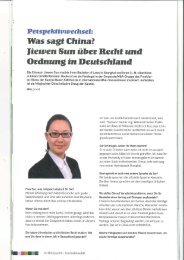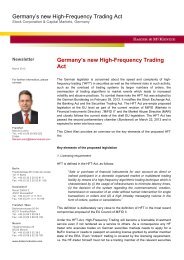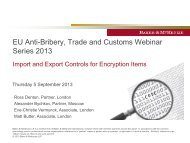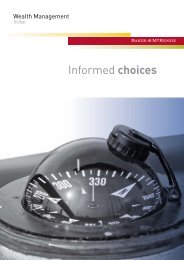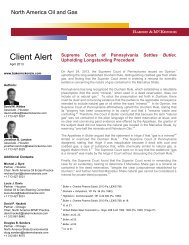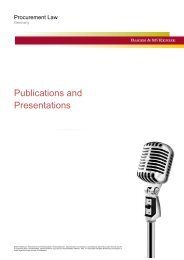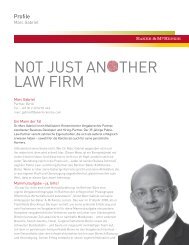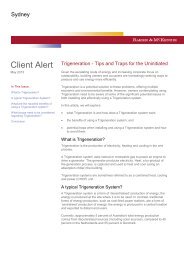Read publication - Baker & McKenzie
Read publication - Baker & McKenzie
Read publication - Baker & McKenzie
Create successful ePaper yourself
Turn your PDF publications into a flip-book with our unique Google optimized e-Paper software.
Canada<br />
stands at the forefront of tax avoidance law in Canada. 65 The GAAR draws a line between<br />
legislative compliance that achieves legitimate tax minimisation and a level of compliance<br />
that frustrates the rationale of the provisions relied upon. The latter constitutes abusive<br />
tax avoidance. 66<br />
Under the GAAR, the taxpayer has the burden of demonstrating that its activities<br />
did not give rise to the particular tax benefit identified by the CRA, or that it engaged in<br />
those activities primarily for bona fide non-tax reasons. If the taxpayer fails to establish<br />
either point, the tax authority has the burden of demonstrating that the resulting tax<br />
benefit is inconsistent with the object, spirit or purpose of the provisions that give rise to<br />
that benefit. It is this ‘abuse analysis’ that forms the crux of the GAAR test. Where the<br />
tax authority succeeds in establishing an abuse of the statutory provisions, the GAAR<br />
operates to deny the benefit in question. Conceptually, the GAAR will apply only where<br />
the abusive nature of a transaction or series of transactions is clear; where the existence<br />
of abusive tax avoidance is unclear, the taxpayer receives the benefit of the doubt. This<br />
structure preserves consistency, predictability and fairness, and reflects the longstanding<br />
principle that taxpayers have the right to arrange their affairs so as to attract the least<br />
amount of tax. 67<br />
IX<br />
DOUBLE TAXATION TREATIES<br />
Canada has one of the world’s most robust bilateral tax treaty networks, comprising<br />
approximately 90 double taxation conventions that are currently in force. 68 Having been<br />
considered in numerous court cases, it is now well established that Canadian tax treaties<br />
are to be read in good faith, with a view to giving their text meaning based upon the<br />
language used and the intentions of the parties. 69 Implementing statutes often make clear<br />
that a particular treaty takes precedence over domestic laws, 70 and judicial precedent,<br />
official commentaries and other extrinsic evidence of the parties’ intentions further assist<br />
in the interpretive exercise. Although most tax treaties are entered into and made law by<br />
the federal government, provincial tax authorities will normally follow the CRA in giving<br />
effect to such treaties by mirroring the resulting federal tax assessments.<br />
It is also notable that the GAAR applies to the provisions of Canadian tax<br />
treaties. 71 The CRA has advanced GAAR arguments in a number of treaty-related<br />
disputes, including ‘treaty-shopping’ cases where taxpayers structure their affairs in an<br />
attempt to use a particular treaty to obtain benefits not available under the domestic laws<br />
65 See, e.g., s. 245.<br />
66 See generally Canada Trustco Mortgage Co v. Canada, 2005 SCC 54, [2005] 2 S.C.R. 601.<br />
67 Commissioners of Inland Revenue v. Duke of Westminster, [1936] A.C. 1 (House of Lords).<br />
68 Canada uses the OECD Model Double Taxation Convention on Income and Capital as the<br />
basis for its tax treaties.<br />
69 See, e.g., Crown Forest Industries Ltd v. Canada, [1995] 2 S.C.R. 802.<br />
70 See, e.g., Canada–United States Tax Convention Act, 1984, S.C. 1984, c. 20, s. 3(2).<br />
71 See, e.g., s. 245(4)(a)(iv).<br />
35



